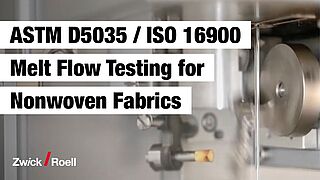Testing of Face Masks to ASTM D5035 / ISO 16900 and Other Test Standards
There is a wide variety of face masks. These range from basic mouth and nose protection to masks with filter elements for protection against small particles to class FFP1, FFP2 or FFP3.
Surgical face masks are intended to protect patients. As class I medical devices they are subject to the requirements of the Medical Devices Regulation 2017/745. Particle filtering respirator masks are intended to protect the wearer from particles, and as personal protective equipment (PPE) of the highest category 3, they are subject to Regulation 2016/425 on personal protective equipment.
Related standards to testing of face masks
The specific requirements for mechanical tests are described in different ASTM, ISO and EN standards, including:
- DIN EN 14683: 2019-10 – Medical face masks – Requirements and test methods
- DIN EN 149: 2009-08 Respiratory protective devices – Filtering half masks to protect against particles – Requirements, testing, marking
- ASTM D5035 - 09 (Reapproved 2017) Standard Test Method for Breaking Strength and Elongation of Textile Fabrics (Strip Method)
Determination of the volume flow index (MVR)
Polypropylene (PP) serves as a raw material, which is spun and meltblown for use in face masks. While the spun form has a low melt flow index, the melt flow index of the meltblown form is three times as high. ZwickRoell’s Mflow can process both materials and delivers accurate and reliable results.
Meltblown Non-Woven Fabrics for Face Masks
In addition to respirator masks, other non-woven, medical protective clothing is manufactured as well. So-called meltblown polypropylene (PP), which functions as a filter, provides the products high filtration efficiency against the smallest particles. Meltblown PP is a non-woven fabric made of extremely fine, melt-spun microfibers.
For quality assurance of the raw material, for example of polypropylene, an extrusion test is performed. The volume flow index (MVR) of these polymers typically lies between 1200 and 2000 cm³/10 min. This places particular demands on the testing system.
With the Mflow, ZwickRoell offers the right instrument to address this challenge. It enables the measurement of high MVRs, and with die plug ensures that the material stays in the extrusion barrel during preheating and that afterward, the test is automatically run with high quality.
Determination of the breaking strength and elongation of face masks to ASTM D5035
In addition to penetration resistance, breaking strength and elongation are important factors in product quality. Breaking strength and elongation are tested according to ASTM D5035. Exact specimen preparation, as well as correct gripping and retightening of the specimen grips are essential for reliable test results.
Determination of the tensile force between mask band and mask body
The connection between the mask band and mask body is a deciding factor for reliable and comfortable use of a face mask, especially over an extended period of time. With a tensile test in accordance to ASTM D5035, the axial tensile force can be determined.
Tensile test on the exhalation valve housing to DIN EN 149
The previous test applications apply to both surgical face masks and PPE respirator masks. Testing to DIN EN 149, on the other hand only applies to PPE respirator masks. If they include one or more exhalation valves and the housing is attached to the mask body, a tensile test is required. The housing must withstand an axial acting force of 10 N for a period of 10 seconds.

